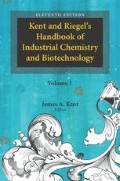Abstract
Industrial gases may actually be used as gases, liquids, or cryogenic liquids. Industrial users generally accept them as those gases used primarily in their pure form in large quantities.
Access this chapter
Tax calculation will be finalised at checkout
Purchases are for personal use only
Preview
Unable to display preview. Download preview PDF.
References
Compressed Gas Association, Inc., Handbook of Compressed Gases, Van Nostrand Reinhold, New York, 1990.
Compressed Gas Association, Inc., Handbook of Compressed Gases, Van Nostrand Reinhold, New York, 1966.
Air Products Industrial Gases Fact Book and Safe Practices Guide, Air Products and Chemicals, Inc., Allentown, PA, 1985.
Vance, R., and Weinstock, H., Applications of Cryogenic Technology, Tinnon-Brown, Inc., Los Angeles, CA, 1969.
Technical Orientation Program, Air Products and Chemicals, Inc., Allentown, PA, 1986.
Schnell, W., Houston, C. D., and Hopper, W., “Membranes Can Efficiently Separate CO2 From Mixtures,” Oil & Gas J., 81(33), 52–56 (Aug. 15, 1983).
Speir, G. A., “Indonesia’s Badak LNG Project Sets New Records,” Pipeline & Gas J. (205), 22–24, 26, 28 (June 1978).
Compressed Gas Association, Inc., Handbook of Compressed Gases, Kluwer Academic Publishers, Boston, 1999.
Castro, R. P., Cohen, Y., and Monbouquette, Y. G., in Proceedings of the 1994 National Conference on Environmental Engineering, p. 82, Boulder, CO, July 1994.
Hydrocarbon Processing, pp. 107–108, Gulf Publishing Co., April 1998.
Depuis, G. E. et al., “Hydrogen Membrane Recovery Estimates,” Hydrocarbon Processing, pp. 61–64, Gulf Publishing Co., April 1993.
Hydrocarbon Processing, pp. 120–124, Gulf Publishing Co., April 1998.
Zolandz, R. W., and Fleming, G. K., in Membrane Handbook, W. S. W. Ho, and K. K. Sirkan (Eds.), Chapter 3, Van Nostrand Reinhold, New York, 1992.
Humphrey, J. L., and Keller, G. E., II: Separation Process Technology, Chapter 5, McGraw-Hill, New York, 1997.
Marshall, T. L., and Garvey, M. D., “Special Report,” CryoGas Internat., November 2000.
Singh, R., “Industrial Membrane Separation Processes,” Chemtech, 33–44, April 1998.
Thorneloe, Cosulick, Pacey, and Roqueta, Landfill Gas Utilization—Survey of United States Projects. Presented at the Solid Waste Association of North America’s Twentieth Annual International Landfill Gas Symposium, Monterey, CA March 25–27, 1997. Published in Conference Proceedings. EPA-ORD 1997.
Hydrocarbon Processing, p. 112, Gulf Publishing Co., April 1998.
Hydrocarbon Processing, pp. 120–124, Gulf Publishing Co., April 1998.
Author information
Authors and Affiliations
Editor information
Rights and permissions
Copyright information
© 2007 Springer Science+Business Media, LLC
About this chapter
Cite this chapter
Cooke, S.J. (2007). Industrial Gases. In: Kent, J.A. (eds) Kent and Riegel’s Handbook of Industrial Chemistry and Biotechnology. Springer, Boston, MA. https://doi.org/10.1007/978-0-387-27843-8_27
Download citation
DOI: https://doi.org/10.1007/978-0-387-27843-8_27
Publisher Name: Springer, Boston, MA
Print ISBN: 978-0-387-27842-1
Online ISBN: 978-0-387-27843-8
eBook Packages: Chemistry and Materials ScienceChemistry and Material Science (R0)

